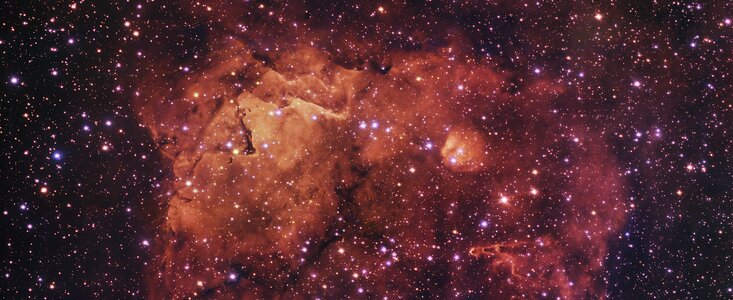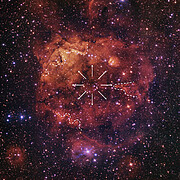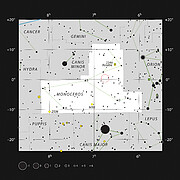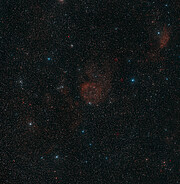Press Release
'Smiling cat' nebula captured in new ESO image
27 June 2023
This cloud of orange and red, part of the Sh2-284 nebula, is shown here in spectacular detail using data from the VLT Survey Telescope, hosted by the European Southern Observatory (ESO). This nebula is teeming with young stars, as gas and dust within it clumps together to form new suns. If you take a look at the cloud as a whole, you might be able to make out the face of a cat, smiling down from the sky.
The Sh2-284 stellar nursery is a vast region of dust and gas and its brightest part, visible in this image, is about 150 light-years (over 1400 trillion kilometers) across. It’s located some 15 000 light-years away from Earth in the constellation Monoceros.
Nestled in the centre of the brightest part of the nebula — right under the ‘cat’s nose’ — is a cluster of young stars known as Dolidze 25, which produces large amounts of strong radiation and winds. The radiation is powerful enough to ionise the hydrogen gas in the cloud, thereby producing its bright orange and red colours. It’s in clouds like this that the building blocks for new stars reside.
The winds from the central cluster of stars push away the gas and dust in the nebula, hollowing out its centre. As the winds encounter denser pockets of material, these offer more resistance meaning that the areas around them are eroded away first. This creates several pillars that can be seen along the edges of Sh2-284 pointing at the centre of the nebula, such as the one on the right-hand side of the frame. While these pillars might look small in the image, they are in fact several light-years wide and contain vast amounts of gas and dust out of which new stars form.
This image was created using data from the VLT Survey Telescope (VST), which is owned by The National Institute for Astrophysics in Italy, INAF, and is hosted at ESO’s Paranal Observatory in Chile. The VST is dedicated to mapping the southern sky in visible light and makes use of a 256-million-pixel camera specially designed for taking very wide-field images. This image is part of the VST Photometric Hα Survey of the Southern Galactic Plane and Bulge (VPHAS+), which has studied some 500 million objects in our home galaxy, helping us better understand the birth, life, and eventual death of stars within our Milky Way.
Links
- Photos of the VST
- Other images taken with the VST
- For journalists: subscribe to receive our releases under embargo in your language
- For scientists: got a story? Pitch your research
Contacts
Juan Carlos Muñoz Mateos
ESO Media Officer
Garching bei München, Germany
Tel: +49 89 3200 6176
Email: jmunoz@eso.org
Bárbara Ferreira
ESO Media Manager
Garching bei München, Germany
Tel: +49 89 3200 6670
Cell: +49 151 241 664 00
Email: press@eso.org
About the Release
| Release No.: | eso2309 |
| Name: | Sh2-284 |
| Type: | Milky Way : Nebula : Appearance : Emission : H II Region |
| Facility: | VLT Survey Telescope |
| Instruments: | OmegaCAM |







